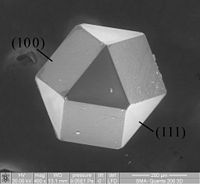
Photo from wikipedia
DOI: 10.1002/adma.201805218 This flourishing activity is well-reflected in this special issue, which features 39 research overviews. Taken together, they portray the state-of-the-art across a very wide range of materials science… Click to show full abstract
DOI: 10.1002/adma.201805218 This flourishing activity is well-reflected in this special issue, which features 39 research overviews. Taken together, they portray the state-of-the-art across a very wide range of materials science topics. This is already a broad collection of work, with the overall activity being even broader, as many groups performing high-quality research could not supply an appropriate overview article in time. The array of articles found in this special issue can be divided into sub-categories in a variety of ways. The one chosen here involves four broad categories: materials for energy and sustainability; nanomaterials; biological, bioinspired, and health-related materials; and other novel materials with unique properties. These categories partly overlap, such that some articles could easily belong to more than one category, but a “primary category” is generally given below, for the sake of brevity. Research into materials for energy and sustainability is a key area for the future of humanity, with the ultimate dream of producing clean and cheap energy while halting and eventually undoing the environmental harm caused by human activity. It is therefore no surprise that many articles in this Special Issue pursue various aspects of this lofty goal. These address challenges and progress along many facets, from energy storage, through catalysis and electrochemistry, to photovoltaics. Within the energy and sustainability studies presented in this Special Issue, Susai et al. review horizons for Li-ion batteries, with an emphasis on high-specific-energy cathodes and chemically active separators. Haber and Leskes show how recent developments in solid-state nuclear magnetic resonance spectroscopy can be used to shed light on the chemical composition and ion transport across electrode–electrolyte interfaces in rechargeable batteries. Grave et al. review the latest understanding of the photoelectrochemical performance of hematite photoanodes for solar water splitting. Zion et al. present the bioinspired electrocatalysis of the oxygen reduction reaction in fuel cells using molecular catalysts. Avnir overviews recent progress in the study of molecularly doped metals with applications in (among other things) catalysis and electrochemistry. Schweke et al. focus on the defect chemistry of oxides used as solid electrolytes in solid oxide fuel cell devices or as catalysts in reduction or oxidation reactions. Rosen and Hod present tunable molecular-scale materials for catalyzing the low-overpotential electrochemical conversion of CO2. Katz et al. show how concentrated sunlight can be used to examine stability and elucidate processes governing the degradation of organic and perovskite-based photovoltaic materials and devices. Finally, Kümmel and Kronik discuss dielectric screening of optimally tuned density functionals as a first principles method for predicting electrical and optical properties of molecular assemblies and solids used for photovoltaics and photocatalysis. Modern materials science would not be where it is without the nanoscience and nanotechnology revolution. Israeli scientists have had many pioneering contributions in this area and Materials science is an inherently interdisciplinary endeavor, which lies at the crossroads of physics and chemistry, and even biology where relevant. It is also a blend of efforts in (at least) synthesis, processing, characterization, and theory. Because everything is made of something, materials science is a crucial enabler of almost any area of engineering, with progress in materials being key to many aspects of modern daily life, from advanced electronics to cutting-edge medical technologies. But materials science is by no means only an applied discipline. It raises many fundamental questions as well and, indeed, the discovery of novel materials phenomena has led to great strides in, e.g., quantum physics and chemistry. In light of the significant role that materials science plays in both basic and applied science, it is no wonder that the materials research scene in Israel is thriving. In fact, materials research in Israel has been recognized by many national and international awards. They are far too numerous to mention in detail here, so it suffices to mention the Nobel Prize awarded to Prof. Dan Shechtman for his discovery of quasicrystals. Three Departments have long been devoted to materials research— the Department of Materials Science and Engineering at the Technion; the Department of Materials Engineering at Ben Gurion University; and my own academic home—the Department of Materials and Interfaces at the Weizmann Institute of Science. These have been joined recently by a newly established fourth one—the Department of Materials Science and Engineering at Tel Aviv University. Exciting Materials Research is by no means limited to these four departments. It is ongoing at departments for physics, chemistry, various engineering disciplines, and even life sciences and medicine, around the country. Indeed, this Special Issue brings together contributions from many schools of thought at six universities—the four mentioned above, as well as the Hebrew University of Jerusalem and Bar Ilan University. Materials research is also pursued via interdisciplinary centers, the most recent one being the Center for Advanced and Intelligent Materials (C-AIM), established at the Weizmann Institute of Science. Materials science is also at the heart of at least two regularly held scientific conferences in Israel—the annual meeting of the Israel Vacuum Society and the biannual Israel Materials Engineering Conference—and is a fixture in (at least) the annual meetings of the Israel Physical Society and the Israel Chemical Society. Israel is also the home of three University Chapters of the Materials Research Society that promote student activities and workshops.
Journal Title: Advanced materials
Year Published: 2018
Link to full text (if available)
Share on Social Media: Sign Up to like & get
recommendations!